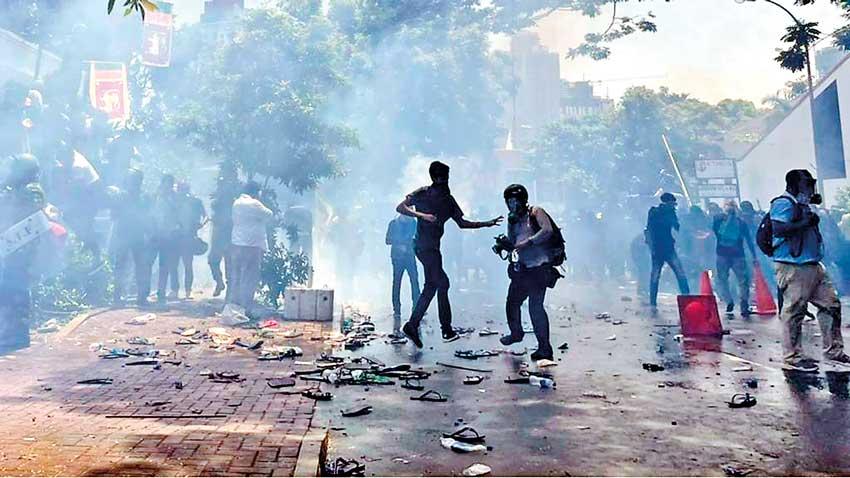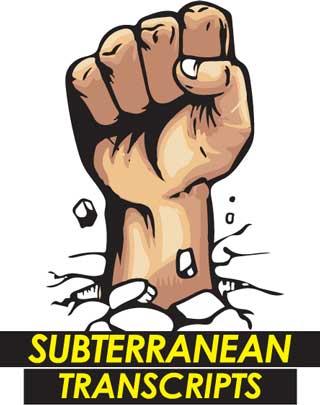Reply To:
Name - Reply Comment

Picture shows protesters brave tear gas and water cannons and attempting to storm the Prime Minister's office at Flower Road in Colombo
 I write (the time is 12.09 pm, on Wednesday) at a time when there is a remarkable and unprecedented lack of political clarity in the country. As I write, Gotabaya Rajapaksa has left the country. As per the Constitution, if indeed Rajapaksa did resign, or, as reported, Rajapaksa citing Article 37.1 of the constitution, Premier Ranil Wickremesinghe has assumed the presidency in an acting capacity. There’s ‘fighting’ within parliament with parties and politicians unable to decide on who Rajapaksa’s successor would be and of course who the next premier should be. There’s fighting among ‘aragalists’ over representational legitimacy, ideological and political thrust, and preferred endgames.
I write (the time is 12.09 pm, on Wednesday) at a time when there is a remarkable and unprecedented lack of political clarity in the country. As I write, Gotabaya Rajapaksa has left the country. As per the Constitution, if indeed Rajapaksa did resign, or, as reported, Rajapaksa citing Article 37.1 of the constitution, Premier Ranil Wickremesinghe has assumed the presidency in an acting capacity. There’s ‘fighting’ within parliament with parties and politicians unable to decide on who Rajapaksa’s successor would be and of course who the next premier should be. There’s fighting among ‘aragalists’ over representational legitimacy, ideological and political thrust, and preferred endgames.
W B Yeates, in his poem ‘The Second Coming,’ seems to have anticipated all this.
Turning and turning in the widening gyre
The falcon cannot hear the falconer;
Things fall apart; the centre cannot hold;
Mere anarchy is loosed upon the world,
The blood-dimmed tide is loosed, and everywhere
The ceremony of innocence is drowned;
The best lack all conviction, while the worst
Are full of passionate intensity

That is a nutshell-capture if ever there was one. All this is new to Sri Lanka and post-Independence generations — yes, even during the UNP-JVP bheeshanaya, the Green-Black July, the long years of terrorist-besieging and at points of economic collapse, things didn’t really fall apart. The centre did hold. Today, there’s no ‘centre’.
There’s struggle of course. That is decent enough English for ‘Aragalaya ,’ after all. Actually it should have been ‘aragala’ considering all pluralities pertaining to aragalists and outcome preferences, which, it was pretty obvious from the get go were glossed over by the singularity of the prominent slogan and end-point envisaged: ‘Gota go home!’ And it was not all about lofty visions of revolutionary change, system transformation and such. As my friend Kanishka Goonewardena put it, ‘It is a bred riot, channelled into #gotagohome.’ True, at a very pertinent level, it was about availability, affordability and the political economy of entitlement.
The struggle, then, had something to do with multiplicity. For now, though, it is about what happens next in terms of the political order, crudely put it is about who takes over. There are three broad struggles unfolding before us. One, within parliament or, let’s say, the established political order which of course is in crisis. Two, there is a struggle outside parliament which has several subplots: a) coherence in terms of political programme, b) agreement on options on the economic front, c) crisis of representational legitimacy. Three, the conflict between ‘the Aragalaya ’ and the ‘political order’. These three are not mutually exclusive of course, but such a characterization is decent enough for analytical ease. Analytical ease notwithstanding, the way each plays out and interacts with one another is marked by one thing and one thing alone: unpredictability.
As one might expect in a mass uprising that is marked by spontaneity and the glossing over of the specific with an all-can-agree objective, the aftermath tends to favour the organized, those with specific agendas. The spoils not necessarily to the aragalists but rather the politicians and political parties, especially if we defer to parliament and constitution. The lack of coherence on all counts on things outside of ‘sending Gota home’ certainly strengthens the hand of the politician.
The eclectic nature of the Aragalaya and aragalists most certainly was a necessary precondition for ‘victory’ but that’s where dreams flounder too. We say this on July 9, 2022. Everything that the Aragalaya stood against was affirmed by ‘aragalists’: theft, vandalism, arson and violence of other kinds. Sure, you cannot blame everyone for the pranks of some, but there were many, academics, journalists, self-appointed radicals etc., who openly spurred them on or turned into shameless apologists. The most generous reading is that all of that was just a manifestation of the degree to which people have been disenfranchised.
As for the position(s) of the Aragalaya, we can also be generous and say ‘early days; they need time to obtain coherence in terms of broader and indeed overall objectives. It will not be clean. The various pretenders to the leadership are putting forward demands/plans that range from minimalistic and decent through iffy to outrageously ridiculous.
Given that PM Ranil Wickremesinghe has assumed power, whether or not he has political control, and considering the declaration of curfew in the Western Province and emergency island-wide, things are coming to a head. How it unfolds is unclear. When and how the political air clears, no one can tell. At some point though, it must be understood that there was a mass movement, incoherent in objective though it was and is, that brought us to where we are right now. Everyone seems to have forgotten that it was essentially an economic and not political crisis that precipitated matters. That remains conspicuously ignored ;beyond the call for immediate relief measures, presumably on the basis of more foreign loans and debt, which is part of the problem rather than the solution, the demands do not address the structural dimension of the economic crisis confronting the country,’ as Kanishka puts it. And as he pointed out, ‘this is precisely the problem concerning which radical demands must be precisely articulated.’
Here are some additional and pertinent points he has made: ‘The Aragalaya —which proudly includes members of all classes—seems to have missed the local and global class dimension of the economic crisis in its demands. The limitations of the political vision of the Aragalaya, restricted to liberal constitutional reform, raises moreover the question about its own representative credentials: how does the Aragalaya authorize itself to speak in the name of the people of Sri Lanka? On what kind of democracy is the Aragalaya itself premised, in order to derive its own political legitimacy in distinction from that of the parliament, with or without constitutional reforms?
‘The Aragalaya is without doubt a popular and mass uprising, diverse in participants and spontaneous in evolution. As such it begs comparison with other revolutionary and non-revolutionary mass uprisings, from the bourgeois French Revolution to the workers’ Bolshevik Revolution to the more recent Arab Spring and Occupy movements. In the more successful among revolutionary uprisings, those that achieved systemic and emancipatory change at the level of social, economic and political structures, revolutionaries produced new political forms in conjunction with fundamental economic transformations. No such radicalism is so far evident in the demands of the Aragalaya —in spite of its rhetoric of radical change. ‘The true challenge for the Aragalaya in Sri Lanka now is to liberate itself from liberal political reformism and co-optation by the actually existing global capitalist economy, ably represented by the US Ambassador in Colombo, and to imagine what real change actually would look like and how another world is possible in Sri Lanka.’
As things stand, considering that the overall political establishment is severely compromised, nay has lost all semblance of legitimacy, whether anyone likes it or not, hope lies with the Aragalaya and Aragalists. The challenges are enormous. It is easy to rubbish them and rubbished they will be, ironically, more so by the classes that never suffered and in fact benefited from the system that has come under fire. May the blood-dimmed tide be turned. May innocence recover its fragrance. May the best renew conviction and may the worst dial down passionate intensity. We are a resilient people. We must prevail.
[email protected].